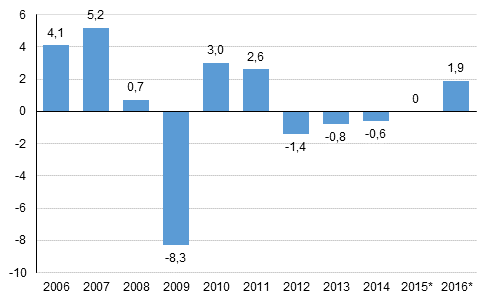Published: 13 July 2017
Gross domestic product grew by 1.9 per cent last year
According to Statistics Finland’s revised preliminary data, the volume of Finland’s GDP grew by 1.9 per cent in 2016. The initial preliminary data released in March put the rate of growth at 1.4 per cent. The GDP became revised as new data on intermediate goods used as production inputs in various industries in particular became available. Gross domestic product, or the value added created in the production of goods and services, amounted to EUR 216 billion.
Annual change in the volume of gross domestic product, per cent

Value added grew in nearly all main industries in 2016.
Viewed by current price, value added increased most in construction, agriculture, forestry and fishing, business activities, other services, information and communication services, and real estate activities, which also includes imputed letting of dwellings. Value added decreased slightly in energy and water supply, public administration and education.
The volume of value added increased most in construction, agriculture, forestry and fishing, and business activities. Volume also grew year-on-year in trade, information and communication services, manufacturing services, real estate activities and other services. The volume of value added declined in energy and water supply and in public administration.
Households’ consumption and private investments boosted demand
Demand in the national economy was mainly boosted by households’ consumption, the volume of which grew by 1.9 per cent. The volume of private consumption grew by 1.8 per cent and the volume of public consumption expenditure by 1.2 per cent.
The volume of investments increased by 7.2 per cent. Private investments grew by 7.9 per cent and government investments by 3.9 per cent. Especially construction investments in machinery and equipment increased. By contrast, investments in research and development and in computer software decreased slightly.
The volume of exports increased by 1.3 per cent in 2016 and that of imports grew by 4.4 per cent. Import prices declined by clearly more than export prices, imports at current prices increased while exports contracted slightly. Exports of goods decreased but the value of imports of goods increased. Exports and imports of services remained at last year’s level.
Last year, net national income grew by 3.1 per cent in real terms, which was clearly more than the gross domestic product because the terms of trade or the ratio between export and import prices improved.
Non-financial corporations’ profits grew
Non-financial corporations' operating surplus describing profits from their actual operations went up by 3 per cent from the previous year. Non-financial corporations’ entrepreneurial income also increased by three per cent as property income and expenditure changed as much. Entrepreneurial income also takes into consideration property income and paid interests and rents, and corresponds roughly with profit before payment of taxes and dividends.
Non-financial corporations’ net lending, or financial position, showed a surplus of EUR 8.7 billion, as against EUR 8.2 billion in the previous year. The financial position improved as profits increased even if non-financial corporations’ investments also grew.
General government’s net lending, or financial position, showed a deficit of EUR 3.8 billion, while the deficit was EUR 5.7 billion in the previous year. Last year, the deficit was 1.8 per cent relative to GDP, which was below the three per cent reference value of the European Union.
Last year, the financial position of central government showed a notable deficit for the eight successive year. The deficit (net borrowing) was EUR 5.8 billion, while one year before it was EUR 6.3 billion. The deficit or net borrowing of local government (municipalities and joint municipal boards, etc.) was EUR 0.9 billion. The surplus of occupational pension funds’ net lending diminished to EUR 2.4 billion from the previous year. The surplus does not include holding gains in assets. Other social security funds showed a surplus of EUR 0.5 billion having been EUR 0.8 billion in deficit in 2015.
The size of the public economy is described by general government's share of the gross value added, which was 19.7 per cent in 2016, having been 20.4 per cent one year earlier.
Households’ disposable income grew by 1.2 per cent in real terms. Households’ adjusted disposable income grew by 0.8 per cent in real terms. Adjusted income also takes into consideration welfare services, i.e. the individual services that general government and organisations produce for households, such as educational, health and social services.
Households’ wage and salary income went up by 1.5 per cent and social benefits by 1.8 per cent. Wage and salary income increased as employment grew. Social benefits increased because the number of pensioners grew. Households’ property and entrepreneurial income went up by 6.4 per cent.
The PDF format table package of the National Accounts will not be produced in future. The publication has included the main aggregates and sector-specific data for the last ten years. The corresponding data are available in Statistics Finland's StatFin database .
Source: National Accounts.
Inquiries: Tuomas Rothovius 029 551 3360, Olli Savela 029 551 3316 , kansantalous@stat.fi
Director in charge: Ville Vertanen
Publication in pdf-format (299.9 kB)
- Reviews
- Tables
-
Tables in databases
Pick the data you need into tables, view the data as graphs, or download the data for your use.
Appendix tables
- Revisions in these statistics
-
- Revisions on these statistics (13.7.2017)
Updated 13.7.2017
Official Statistics of Finland (OSF):
Annual national accounts [e-publication].
ISSN=1798-0623. 2016. Helsinki: Statistics Finland [referred: 8.12.2025].
Access method: http://stat.fi/til/vtp/2016/vtp_2016_2017-07-13_tie_001_en.html

